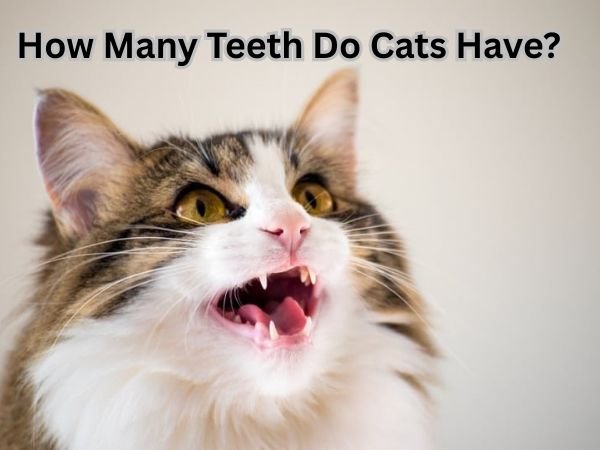
Have you ever watched your cat yawn and wondered about those sharp little teeth gleaming in their mouth? Or perhaps you’ve felt those tiny needle-like teeth during a playful nip and found yourself curious about your feline friend’s dental makeup? How Many Teeth Do Cats Have? The answer might surprise you – adult cats have exactly 30 permanent teeth, perfectly designed for their carnivorous lifestyle. Unlike humans with our 32 teeth built for grinding and chewing various foods, cats possess a specialized set of teeth that tell an incredible story about evolution, hunting, and survival. From their razor-sharp canines to their scissor-like molars, every tooth serves a specific purpose in your cat’s daily life.
In this article, we’ll explore 7 amazing truths about feline teeth that will change how you view your pet’s dental health. You’ll discover fascinating facts about cat dental development, why proper pet oral care matters more than you think, and surprising insights that will make you appreciate the remarkable design of your cat’s mouth.
Truth #1 – Adult Cats Have 30 Permanent Teeth (But Kittens Are Different)
How Many Teeth Do Cats Have? If you’ve ever wondered about your feline friend’s pearly whites, you’re not alone! Many cat parents are curious about their pet’s dental health, and it all starts with a simple question: how many teeth do cats actually have?
The straightforward answer: adult cats have 30 permanent teeth. But there’s more to this story, especially when it comes to our adorable kittens!
Adult Cat Teeth Breakdown
Your fully grown cat’s mouth contains:
- 12 incisors – Those tiny front teeth for nibbling
- 4 canines – The sharp “fangs” for gripping prey
- 10 premolars – For cutting and shearing food
- 4 molars – The back teeth for grinding
Kittens Start With Just 26 Baby Teeth
Just like human babies, kittens are born toothless and develop their first set of teeth around 2-3 weeks old. These baby teeth include:
- 12 incisors
- 4 canines
- 10 premolars
- No molars (that’s the key difference!)
Kittens lose these baby teeth between 3-6 months old as their permanent teeth come in.
How Do Cats Compare to Other Pets?
To put this in perspective:
- Cats: 30 permanent teeth
- Dogs: 42 permanent teeth
- Humans: 32 permanent teeth
So your cat actually has fewer teeth than you do! But don’t worry – those 30 teeth are perfectly designed for their carnivorous lifestyle.
Understanding your cat’s dental structure helps you better care for their oral health and know what’s normal as they grow from playful kittens into adult companions.
Truth #2 – Cat Teeth Are Perfectly Designed for Hunting
Your cat might spend most of their day napping in sunny spots, but their teeth tell a different story. Every tooth in your feline friend’s mouth is a masterpiece of evolution, perfectly crafted for their role as natural-born hunters.
Nature’s Perfect Hunting Tools
When you look at your cat’s teeth, you’re seeing millions of years of evolution at work. These cat teeth facts reveal just how specialized our furry companions really are. Unlike humans who need teeth for various foods, cats have carnivore teeth designed for one main purpose: catching and eating meat.
The Four Types of Hunting Teeth
Canine Teeth (The Famous Fangs)
Those impressive pointed teeth aren’t just for show:
- Puncture prey with precision
- Hold struggling animals securely
- Deliver the final bite that ends the hunt
- Work like nature’s own daggers
Premolars and Molars (The Power Tools)
These back teeth are your cat’s heavy-duty equipment:
- Shear meat like scissors
- Crush bones of small prey
- Tear tough tissue into manageable pieces
- Function as built-in meat processors
Incisors (The Tiny Front Teeth)
Those small front teeth have big jobs:
- Grooming their fur to perfection
- Gripping small objects during play
- Scraping meat off bones
- Nibbling delicately when needed
Why This Matters for Pet Owners
Understanding your cat’s tooth design helps explain their behavior. When your kitty “kneads” you with their paws or gives you gentle nibbles, they’re using instincts tied to these specialized teeth. It’s also why cats prefer certain textures in their food and toys.
Your house cat may never hunt mice, but their teeth remain perfectly designed predator tools – a fascinating reminder of their wild heritage living right in your living room.
Truth #3 – Kittens Go Through a Complete Tooth Transformation
Just like human babies, your adorable kitten isn’t born with a full set of pearly whites! The journey from gummy smiles to sharp adult teeth is quite fascinating.
When Do Those Tiny Teeth First Appear?
Your kitten’s baby teeth start poking through their gums when they’re just 2-3 weeks old. These needle-sharp little teeth are perfect for nursing and exploring their new world. You might notice your kitten becoming more playful and wanting to nibble on everything – that’s completely normal!
The Great Tooth Swap Begins
Here’s where things get interesting. Around 3-4 months old, your kitten will start losing those baby teeth. Don’t panic if you find tiny teeth around the house or notice your kitten pawing at their mouth. This is all part of growing up!
During this phase, you might notice:
- Your kitten chewing more than usual
- Slightly swollen or red gums
- Small amounts of blood on toys (this is normal)
- Finding tiny teeth in their food bowl or around the house
Mission Complete: Full Adult Teeth
By the time your kitten reaches 6-7 months old, they’ll have their complete set of 30 adult teeth. These permanent teeth are built to last a lifetime with proper care.
How Does This Compare to Human Kids?
The process is surprisingly similar to human tooth development! While human children typically lose their first tooth around age 6 and finish the process by age 12, kittens speed through this transformation in just a few months. Both species experience some discomfort during teething, making it a universal growing pain that connects us with our furry friends.
Pro tip: Provide soft chew toys during this transition period to help soothe your kitten’s gums and protect your furniture!
Truth #4 – Each Type of Cat Tooth Has a Specific Purpose
Have you ever wondered why your cat’s teeth look so different from yours? Just like how we use different tools for different jobs, cats have specialized teeth designed for their unique needs. Let’s explore the fascinating world of cat tooth anatomy and discover how each type of cat teeth serves a specific purpose.
The Four Types of Cat Teeth
Incisors (12 total): The Tiny Groomers
Those small front teeth aren’t just for show! Your cat’s incisors are like tiny tweezers, perfect for:
- Nibbling and grooming their fur
- Removing debris from their coat
- Gentle biting during play
- Picking up small objects
Think of them as your cat’s personal grooming tools – they’re always working to keep that beautiful coat clean and tidy.
Canines (4 total): The Mighty Fangs
These are the impressive pointed teeth that make your cat look fierce. The canines are your cat’s power tools:
- Sharp fangs for biting and tearing prey or food
- Holding onto objects securely
- Defense when needed
- The signature “vampire” look that makes cats so distinctive
Premolars (10 total): The Multi-Taskers
Located on the sides of your cat’s mouth, premolars are the workhorses:
- Side teeth for grinding and shearing food
- Breaking down chunks into smaller pieces
- Working together with the tongue to move food around
These teeth do most of the heavy lifting when your cat eats.
Molars (4 total): The Heavy-Duty Crushers
At the very back, molars are built for tough jobs:
- Back teeth for crushing harder materials
- Processing bones and tougher food textures
- Final breakdown before swallowing
Each type of tooth works together like a well-organized team, ensuring your feline friend can eat, groom, and live comfortably. Pretty amazing how nature designed such a perfect dental system, isn’t it?
Truth #5 – Cats Can Suffer Serious Dental Problems Without Proper Care
Your cat’s adorable little fangs aren’t just for show – they need serious care to stay healthy! Just like humans, our feline friends can develop painful dental problems that affect their quality of life.
The Shocking Reality About Cat Dental Health
Here’s a statistic that might surprise you: 80% of cats show signs of dental disease by age 3. That means most cats are walking around with uncomfortable mouths, often suffering in silence.
Tooth Resorption
- Most painful dental condition in cats
- Teeth literally dissolve from the inside out
- Often requires tooth extraction
Gingivitis
- Red, swollen gums
- Early stage of gum disease
- Reversible with proper care
Periodontal Disease
- Advanced gum disease affecting tooth support
- Can lead to tooth loss
- May cause infections that spread to other organs
Warning Signs Your Cat Has Dental Problems
Keep an eye out for these red flags:
- Bad breath (beyond normal “cat breath”)
- Excessive drooling or pawing at the mouth
- Difficulty eating or dropping food while chewing
- Yellow or brown tartar buildup on teeth
- Red, swollen, or bleeding gums
- Changes in eating habits or appetite loss
Why This Matters for Your Cat
Dental problems aren’t just about bad breath. Untreated issues can:
- Cause severe pain and discomfort
- Lead to difficulty eating and weight loss
- Result in serious infections
- Affect your cat’s overall health and happiness
Remember, cats are masters at hiding pain, so regular dental checkups with your vet are essential for catching problems early!
Truth #6 – Your Cat’s Teeth Need Regular Care and Maintenance
Just like us humans, your feline friend’s pearly whites need some TLC to stay healthy and strong. Many cat owners don’t realize that dental care is just as important for cats as it is for people. Let’s dive into what you need to know to keep your kitty’s smile bright!
Daily Brushing Recommendations
Start small and be patient. Most cats aren’t thrilled about having their teeth brushed at first, but with the right approach, it can become routine.
Here’s how to make it work:
- Begin by letting your cat get used to having their mouth touched
- Use a finger brush or soft-bristled toothbrush designed for cats
- Only use cat-specific toothpaste (human toothpaste is toxic to cats!)
- Aim for 2-3 times per week, working up to daily brushing
- Keep sessions short – even 30 seconds is better than nothing
Pro tip: Reward your cat with treats or playtime after each brushing session to create positive associations.
VOHC-Approved Dental Products
The Veterinary Oral Health Council (VOHC) tests and approves products that actually work for pet dental health. Look for their seal of approval on:
- Dental treats and chews – These help scrape away plaque as your cat chews
- Water additives – Easy to use, just add to their drinking water
- Special dental diets – Kibble designed with texture that cleans teeth
- Dental toys – Rope toys and textured balls can help with plaque removal
Professional Cleanings Frequency
Most cats need professional dental cleanings every 1-3 years, depending on their age, breed, and overall dental health. Your vet will let you know what’s right for your specific cat.
During professional cleanings, your vet will:
- Remove tartar and plaque from above and below the gum line
- Polish the teeth
- Check for any dental problems or disease
- Sometimes take dental X-rays if needed
Diet’s Role in Dental Health
What your cat eats plays a huge role in their dental health. Here’s what helps:
Dry kibble vs. wet food:
- Dry food can help scrape teeth clean as cats chew
- Wet food tends to stick to teeth more
- A mix of both is often ideal
Special dental diets:
- Larger kibble pieces encourage more chewing
- Special textures help clean teeth naturally
- Some are formulated to reduce tartar buildup
Foods to avoid:
- Too many soft treats that stick to teeth
- Human food (especially anything with sugar)
- Low-quality foods with lots of carbs
Remember, good dental care isn’t just about fresh breath – it prevents painful dental disease and can add years to your cat’s life. Start slowly, be consistent, and don’t hesitate to ask your vet for guidance. Your furry friend will thank you for it!
Truth #7 – Indoor vs. Outdoor Cats Use Their Teeth Differently
Ever wondered if your cozy indoor cat really needs all those sharp teeth? The answer might surprise you! While both indoor and outdoor cats have the same dental setup, they use their pearly whites in completely different ways.
How Outdoor Cats Put Their Teeth to Work
Outdoor cats are basically tiny wild hunters, and their teeth reflect this lifestyle:
Hunting Applications
- Catching prey – Those sharp canines are perfect for gripping mice and birds
- Killing bite – Back molars deliver the final, precise bite to small prey
- Tearing meat – Carnassial teeth work like scissors to slice through tough tissue
Defense Mechanisms
- Warning displays – Baring teeth sends a clear “back off” message
- Fighting – Sharp teeth become weapons during territorial disputes
- Climbing escapes – Teeth help grip tree bark during quick getaways
Indoor Cats: Different Teeth, Different Jobs
Your pampered house cat might seem like they live an easy life, but their teeth stay plenty busy:
Daily Dental Duties
- Kibble crushing – Those back molars work hard breaking down dry food
- Wet food management – Front teeth help grab and position chunks
- Treat demolition – Ever watch your cat attack a dental chew? Pure determination!
Grooming Essentials
- Fur maintenance – Front teeth work like tiny combs during self-grooming
- Nail care – Cats use their teeth to clean and maintain their claws
- Hard-to-reach spots –Teeth help access areas paws can’t reach
Why Indoor Cats Still Need All Their Teeth
Here’s the thing – even though your indoor cat isn’t hunting gazelles, every single tooth matters:
- Complete nutrition absorption: Missing teeth can make eating difficult and lead to digestive issues.
- Quality of life: Dental pain affects mood, playfulness, and overall happiness.
- Grooming ability: Cats with dental problems often develop matted fur and hygiene issues.
- Future flexibility: You never know when circumstances might change, and healthy teeth provide options.
Whether your cat spends their days stalking toy mice or real ones, those 30 teeth serve important purposes. Indoor cats might not need their hunting instincts, but they definitely need healthy teeth for comfortable eating, proper grooming, and overall wellbeing.
Keep those chompers clean with regular brushing, dental treats, and vet checkups – your indoor tiger will thank you for it!
Conclusion
Your cat’s 30 teeth work together as a specialized toolkit for eating, grooming, and protection. Each tooth type has its job – from those tiny incisors that help with precise grooming to the powerful canines that show their wild heritage.
- Take action today: Schedule a dental checkup with your vet if it’s been over a year. They can spot problems early and show you the best brushing techniques for your specific cat.
- Remember: Preventive dental care starting in kittenhood sets the foundation for a lifetime of healthy teeth. Your cat can’t tell you when something hurts, so regular dental care is one of the best gifts you can give them.
Start small – even letting your cat lick toothpaste off your finger is progress. Your future self (and your cat) will thank you for taking their dental health seriously today.
FAQ
How many teeth do cats have?
Adult cats have 30 teeth, while kittens start with 26 baby teeth. These teeth help them eat, chew, and hunt.
Do cats lose their baby teeth?
Yes, kittens lose their baby teeth around 3 to 6 months old. Adult teeth then grow in to replace them.
When do cats get their adult teeth?
Cats usually get all 30 adult teeth by the time they are 6 to 7 months old.
What happens if a cat loses adult teeth?
If a cat loses adult teeth, they will not grow back. Dental care is important to keep teeth healthy.
How can I keep my cat’s teeth healthy?
Brush their teeth with pet-safe toothpaste, give dental treats, and schedule vet check-ups to prevent dental disease.




